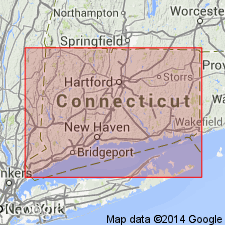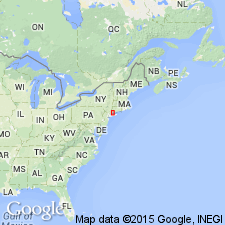
- Usage in publication:
-
- Danbury granodiorite gneiss
- Modifications:
-
- Original reference
- Dominant lithology:
-
- Granite
- Diorite
- AAPG geologic province:
-
- New England province
Summary:
Pg. 104, 108, and map. Danbury granodiorite gneiss. Presents two important facies—biotite granite and a diorite in which hornblende becomes an important constituent and quartz is less prominent. The two grade into each other, although generally speaking, more hornblende occurs in Greenwich and Wilton areas and parts of Monroe than in the mass north of Danbury. The rock is prevailingly porphyritic, with pink or white phenocrysts of feldspar, closely crowded, often attaining a length of 1 to 2 inches. The groundmass in which the larger feldspar cyrstals are set consists essentially of two varieties of feldspar, quartz, and biotite or hornblende or both. Of igneous origin and intruded before metamorphic action converted igneous and sedimentary rocks alike into gneisses and schists.
Source: US geologic names lexicon (USGS Bull. 896, p. 569-570).

- Usage in publication:
-
- Danbury granodiorite gneiss
- Modifications:
-
- Areal extent
- AAPG geologic province:
-
- New England province
Summary:
Danbury granodiorite gneiss of 1907 map of Connecticut, by H.E. Gregory and H.H. Robinson, continues into Westchester County, New York, where it is called Harrison diorite. It includes a number of more or less intermingled rock types whose different phases are not equally developed in all areas in which they occur. It is not a unit but a very variable formation, usually with high content of hornblende and a porphyritic aspect. It grades into biotite schists and quartz-oligoclase-biotite gneisses and all these types are intersected and sometimes intimately penetrated by granite and pegmatite. Writer tentatively places the complex in pre-Cambrian with probably exception of the youngest granite, which may be as young as Ordovician.
Source: US geologic names lexicon (USGS Bull. 896, p. 569-570).
For more information, please contact Nancy Stamm, Geologic Names Committee Secretary.
Asterisk (*) indicates published by U.S. Geological Survey authors.
"No current usage" (†) implies that a name has been abandoned or has fallen into disuse. Former usage and, if known, replacement name given in parentheses ( ).
Slash (/) indicates name conflicts with nomenclatural guidelines (CSN, 1933; ACSN, 1961, 1970; NACSN, 1983, 2005, 2021). May be explained within brackets ([ ]).

